

![]()
HERDING DOGS OF ASIA
THE HERDING DOGS OF RUSSIA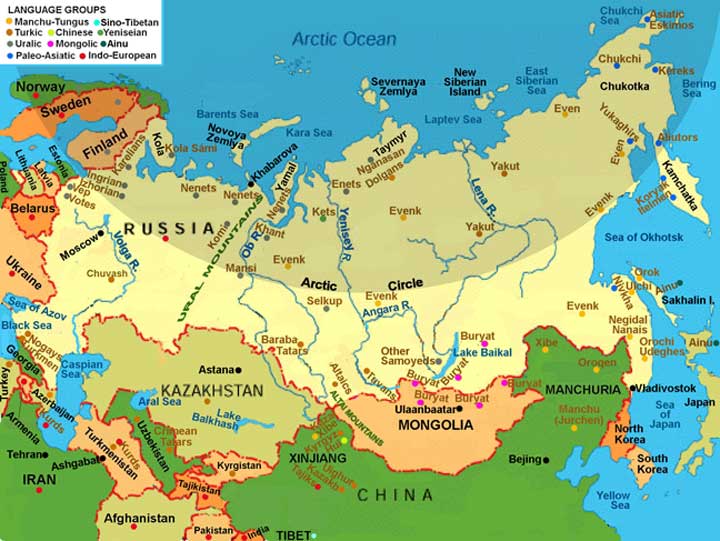
Above, a map of Asia with indigenous populations indicated.
Russia is a vast country, the largest country in the world, and although the bulk of it lies in Asia, the concentration of its population is in Europe. The Ural Mountains divide the continents of Europe and Asia. Those people that reside in the Asian portion of Russia, also known as Siberia, consist of many ethnic and linguistic groups that are often as culturally dissimilar from each other as they are from Russian nationals. Because of this I had to approach this article from a somewhat different viewpoint than the other articles in this series. Instead of dividing it by country, since Russia is a single country, I have divided it by language group. It is still devoted to herding dogs, which, however, cannot be understood without an understanding of the people who own, work, and breed them.
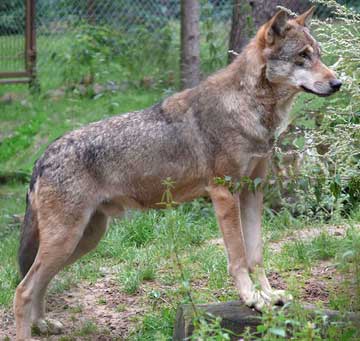 Left, the Eurasian Wolf. (Photo from Wikipedia, by Gunnar Riesand, and reprinted with permission under the GNU Free Documentation License 1.2.)
Left, the Eurasian Wolf. (Photo from Wikipedia, by Gunnar Riesand, and reprinted with permission under the GNU Free Documentation License 1.2.)
According to Professor Andrey Borodovsky, an archaeologist, "Siberia has always been a kind of 'stream of civilization'--a transit territory, rich with resources and attractive for migration". Parts of the Russian Steppe and the entire forest steppe to its north (a grassland interspersed with woodland or forest) have been destroyed by modern agriculture and industrialization, its people displaced. However, there is an even more enormous stretch of taiga, gigantic boreal forests of mostly coniferous trees, that covers most of northern and eastern Siberia, and though winters are very cold and summers very short, it provides a rich environment. And then there is the swathe of tundra in the far north of Siberia. In the 19th and 20th centuries, when Westerners were beginning to notice the tundra, it appeared, as Mrs. Kilburn Scott, an early breeder of Samoyed dogs, quoting an un-named source, said, as "an absolutely treeless waste, lichened, swampy, intersected by streams--this is the true Tundra. It runs in a belt, 500 miles at its widest point, for 4,000 miles along the shores of the Arctic Ocean".
Where the steppe still exists as a grassy plain, a few nomadic groups today still herd horses, sheep, and camels on horseback; but the vast ecosystems of the taiga and the tundra, are home to nomadic reindeer herders and hunters, who, despite their environment's shortcomings, have fashioned a culture and lifestyle from what is available to them. Their ancestors may or may not have originally been nomads of the steppe, but the tundra and the taiga are not suitable arenas for horses.
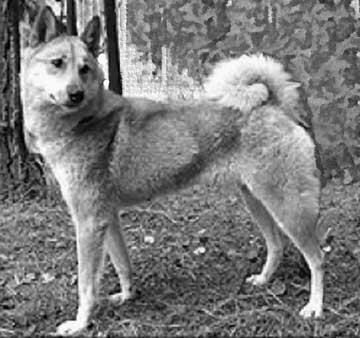
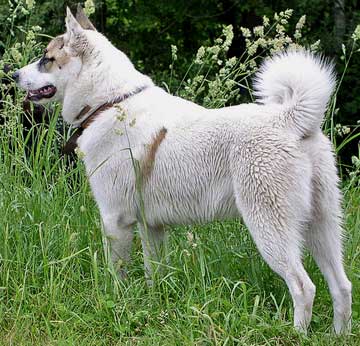 Left, an old photo of a West Siberian Laika. Compare it to the photo of the show type of West Siberian Laika, right. (Both photos from Wikipedia and in the public domain.)
Left, an old photo of a West Siberian Laika. Compare it to the photo of the show type of West Siberian Laika, right. (Both photos from Wikipedia and in the public domain.)
Most of the dogs of Siberia belong to the laika group, a class of dogs that are northern or spitz-types, similar to the Scandinavian herding breeds. DNA evidence shows that dogs of the northern breeds, such as reindeer herding dogs in this article, belong to a group that shows a closer relationship to the modern wolf, suggesting that these breeds were produced by deliberately crossing already domesticated dogs with wild wolves. Of the spitz-type dogs, Bonnie Dalzell, a paleontologist and free-lance writer on natural history subjects, says, "Physically spitz breeds are very close to the wolf ancestors of dogs. Take a wolf and curl its tail and you have a [spitz-type dog]. However behaviorally they are dogs and...they lack the full repetoire of mature wolf behaviors...Spitz breeds are square proportioned dogs with prick ears and a curled tail. The northern...spitzes generally have a primitive type coat with guard hairs around 2 inches long and an undercoat which thickens in winter. Many spitz breeds are general purpose dogs in their native lands, used for hunting, hauling, [herding,] and guarding."
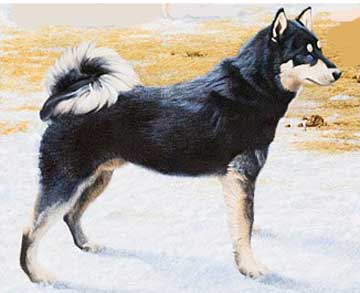
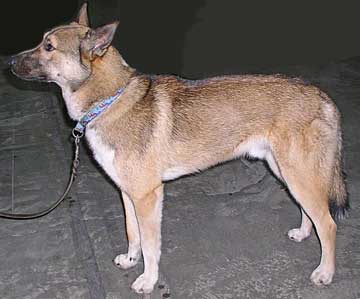 Left, a drawing of a East Siberian Laika. (From Ajar Varlamov.)
Left, a drawing of a East Siberian Laika. (From Ajar Varlamov.)
Right, an East Siberian Laika said to be a show type. (Photo left, by "PrzmekL" from Wikipedia, in the public domain.)
Laika means "to bark" in Russian and as we have seen with the other herding spitz, these dogs work noisily. At one time, there were many types of laika. Today, the differences among them are slight and may be more of size than anything else and in individual instances, any of these dogs might be used interchangeably for herding, hunting, and hauling, and seem to be able to handle the job. Laikas are indigenous to Siberia and may be called a Siberian landrace dog, shaped by their environment, much like the people. Hunting laikas are used to hunt everything from squirrel to bear. Sled dogs are used as draft animals for carrying loads or for transportation. Some laika types have been developed into named breeds, for example, the East Siberian Laika, the largest, bred specifically for hunting bear and elk (wild reindeer), and the West Siberian Laika, a medium-sized dog bred to hunt sable, ermine and other smaller animals. These two breeds are currently recognized by the FCI, along with the Russo-European Laika, a breed that was developed in the 1940s, and they are listed as "Russian Sled Dogs" despite the fact that their primary job was hunting.
Below, two Russo-European Laikas baiting a bear. (From an original photo. Source unknown.)
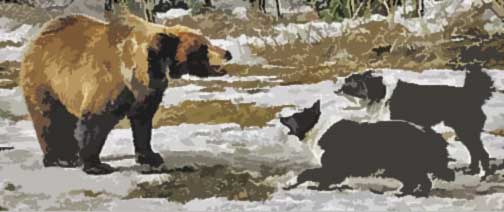
Paleo-Asiatics
Genetics has shown that the first people to live in central Siberia arrived around 45,000 years ago. These earliest inhabitants are known as Yeniseians, after the Yenisey River in north-central Siberia where archaeological evidence of them first appeared. It is unclear where they originated. They spoke a different language from the Uralic and Turkic peoples who came after them and their language has been tentatively associated with Na-Dené, a major language family of the Americas.
The Kets
The Kets, a hunter-fisher people of central Siberia, are believed to be the last survivors of this earliest migration. They were variously called Ostyaks or Yenisey-Ostyaks. They speak a language that is currently considered an "isolate" or the only surviving member of its language group. Yeniseian is a language of the western branch of the Paleo-Asiatic family. Their word for reindeer is borrowed from the Samoyedic languages so it is not likely that they herded reindeer until they were forced into adjacency with the Samoyed peoples. It is unclear if they use dogs to herd reindeer. There are fewer than 1500 Kets today.
Other Paleo-Asiatic Speakers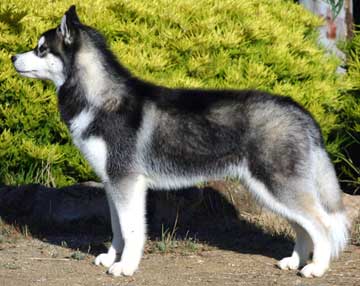
In the far east of Siberia live people who speak languages of the eastern branch of the Paleo-Asiatic family, such as the Chukchi, Kereks, Aleuts, Aliutors, Koryaks, and Asiatic Eskimos (Yupiks). Only some of these people breed reindeer, and those usually because it was forced upon them when Russia collectivized. Most are fishermen and hunters of sea mammals. The Chukchi breed and use laika sled dogs (see below) for transportation and draft, and their dogs are attributed as being the progenitors of the Siberian Husky, although the Yakut (see below) also make this claim for their laika sled dogs.
Right, a Siberian Husky, show variety. (Photo by "Utopialand" from Wikipedia and reprinted with permission under the GNU Free Documentation License 1.2.)
Uralic Peoples
Many of the indigenous people of the Ural Mountain region speak languages that belong to the Uralic family. This includes the Sámi and Samoyedic languages, but it also includes some surprising members, including Finnish, Estonian, and Hungarian. It gives a clue as to the origin of the speakers, even though some of them are living far from the Ural Mountains today. The Samoyedic languages belong to the Finno-Ugric branch of the Uralic language family. Acording to David Anthony, an archeologist, etymology indicates that the proto-Uralic people "lived far from the sea in a forest environment. They were foragers who hunted and fished but possessed no domesticated plants or animals except the dog [emphasis mine]." However, there is no indication that these people herded reindeer or used herding dogs. It is more likely that they used dogs for hunting or draft.
Kola Sámi
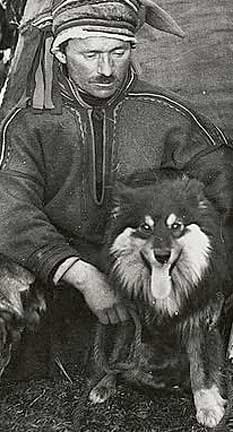
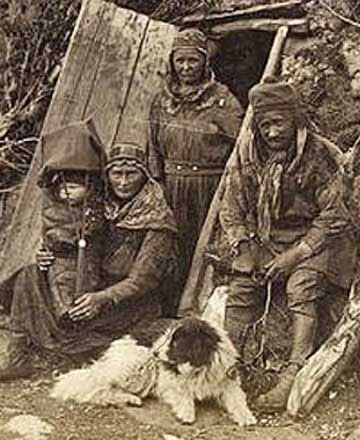 Left, a Sámi man with his Finish-type reindeer herding dog. (Photo pre-1936 and in the public domain.)
Left, a Sámi man with his Finish-type reindeer herding dog. (Photo pre-1936 and in the public domain.)
Right, a Sámi family from the 1870s with their laika-type reindeer herding dog. (Photo in the public domain.)
We visited the Sámi people living in northern Scandinavia. There are also Sámi people living on the Kola Peninsula, a portion of the Scandinavian Peninsula east of Finland belonging to Russia. Sámi people have lived on the Kola Peninsula since the end of the first millennium AD. They are primarily reindeer herders and they use dogs that are similar to, if not the same as, the Laphunds and the Lapponian Herder.
Samoyeds
The Samoyeds came from the northern Ural Mountains region which indicates they had separated from other Uralic-speakers prior to moving north. Remainders of this culture are the Nenets and the Enets, both reindeer-herding people, and the Nganasan, a reindeer hunting culture who use dogs for pulling sleds, all of the northern branch of Samoyeds; and the Selkups, Karagas, Kamas, Motor or Mator, Taigi, and Soyets, all of the southern branch of the Samoyeds. Apart from the Selkups, these latter are few in number and some may already be extinct. The Selkups are reindeer herding people who use dogs for hunting and reindeer for draft.
Nenets
The Nenets or Yurak Samoyeds are the largest Samoyedic group extent today. They are a nomadic people that have a subsistence culture and make their living from hunting and reindeer herding. Reindeer are used for draft. The Nenets live today on both sides of the Ural Mountains, in far northern Russia, and on the Yamal Peninsula, which extends into the Kara Sea. During their yearly migration they move huge herds of reindeer from summer pastures in the north to winter pastures just south of the Arctic Circle, about 1000-1500 kilometers (approximately 600-900 miles). They use a lasso and a pole with a noose end to catch and control reindeer for draft. It is with these people that the herding leika may have originated.
The Herding Laika.
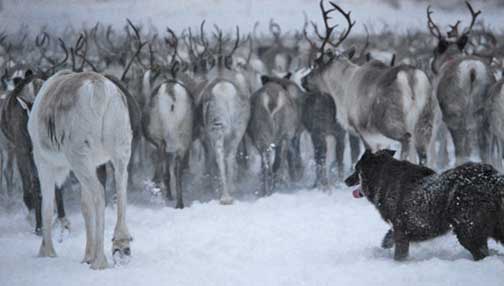 Left, a Nenets herding laika at the back of his reindeer herd. (Photo courtesy of Silja Jonsson from Sweden.)
Left, a Nenets herding laika at the back of his reindeer herd. (Photo courtesy of Silja Jonsson from Sweden.)
Reindeer herding dogs are the smallest of the laika-types and expected not only to herd reindeer, but to hunt small animals, like the Arctic fox whose pelt provides income. The reindeer-herding laika is often called the Nenets Herding Laika. It is a medium-sized dog with a thick double coat that is solid or bicolored, in grey, tan, black or white, similar to the Lapphunds.
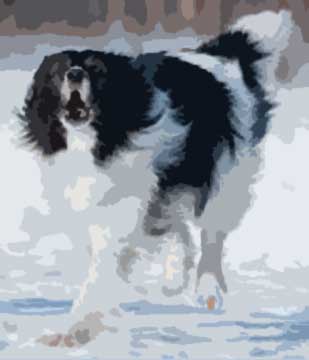 So far there is no indication that the herding leikas (with the exception being the Samoyed dog, below) have been particularly noticed by the Dog Fancy outside of Russia, which is both a blessing and a curse. A blessing because, as I have said many times before, a recognized breed is a changed breed. A curse because it is difficult to gather any information about them. That does not mean they have gone completely unnoticed. In 1994, the Russian Kynologic Federation (RKF) approved the first official standard of the breed and named it the "Reindeer Herding Spitz." However, thus far, it has escaped FCI scrutiny. This is not to say that the dog registered by the RKF is the same as the dog used by the Nenets and other reindeer herding groups. Far from it I would expect, because the Reindeer Herding Spitz has now been literally groomed for the show ring and is being bred to a standard of looks.
So far there is no indication that the herding leikas (with the exception being the Samoyed dog, below) have been particularly noticed by the Dog Fancy outside of Russia, which is both a blessing and a curse. A blessing because, as I have said many times before, a recognized breed is a changed breed. A curse because it is difficult to gather any information about them. That does not mean they have gone completely unnoticed. In 1994, the Russian Kynologic Federation (RKF) approved the first official standard of the breed and named it the "Reindeer Herding Spitz." However, thus far, it has escaped FCI scrutiny. This is not to say that the dog registered by the RKF is the same as the dog used by the Nenets and other reindeer herding groups. Far from it I would expect, because the Reindeer Herding Spitz has now been literally groomed for the show ring and is being bred to a standard of looks.
Right, a Reindeer Herding Spitz, the breed developed from the Herding Laika for the show ring. (Source unknown.)
Below, three herding laikas pose by a sled with a Nenets woman and two shy children from Yamal Peninsula in Siberia. (Photo copyright © by Sergey Anisimov and reprinted with kind permission.)
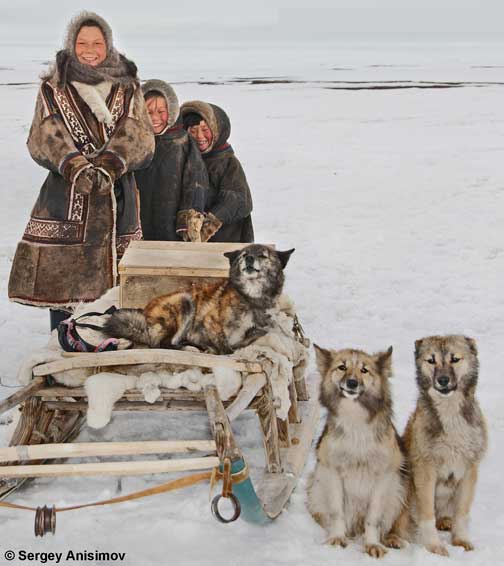 Getting back to the genuine herding leika, it appears that this type and the use of it spread well beyond the Nenets. In 1937, Mikhail Georgievich Volkov, a wildlife biologist, mounted an expedition to the Yamal Peninsula to survey the Nenets reindeer herding laikas, and to purchase some of them and ship them to the Chukotka Peninsula in the far northeast of Siberia for breeding and distribution to the Evens, the Koryaks, and other reindeer herding people of that region who up until that time did not use herding dogs. Volkov left a journal in which he described the Nenets year:
Getting back to the genuine herding leika, it appears that this type and the use of it spread well beyond the Nenets. In 1937, Mikhail Georgievich Volkov, a wildlife biologist, mounted an expedition to the Yamal Peninsula to survey the Nenets reindeer herding laikas, and to purchase some of them and ship them to the Chukotka Peninsula in the far northeast of Siberia for breeding and distribution to the Evens, the Koryaks, and other reindeer herding people of that region who up until that time did not use herding dogs. Volkov left a journal in which he described the Nenets year:
"Summer. Reindeer herding near places convenient for fishing and hunting waterfowl...[and] sea mammals....Fall. Accelerated migration to winter pastures....polar fox hunting in early November. When Polar night sets in, a new job emerges and this is to protect reindeer from wolves for 24 hours, every single day. Winter. In early winter the nomads are busy dividing their time equally between reindeer herding and hunting. In December, the snow cover is thick enough, deer do not scatter much and the attacks of wolves diminish.... Spring. From middle to late March, nomads start migrating back to summer pastures. This continues until late May-early June and it is accomplished not as fast as the fall migration was, because...reindeer are exhausted, females are pregnant, and...calves...cannot move fast. During this time nomads are busy attending their reindeer herds."
Volkov also noticed that there were two varieties of the Nenets' herding laika: one, the longhaired variety (we would call it rough coated), called Erre by the Nenets, and the other, a relatively shorthaired variety, called Yando. He wrote, "Nenets reindeer herdsmen see no differences in their work on reindeer, but they consider Yando type dogs older [i.e., more ancient] than the Erre type." There were more longhaired dogs, however, than shorthaired, and the predominant colors were white (see "The Samoyed", below), white with black, and black with white. These dogs were expected to herd reindeer and hunt fox and waterfowl. The Nenets usually kept some dogs in their chum (tent) at night and tied two dogs outside (probably to give the alarm). "The number of dogs inside the chum," Volkov said, "usually determines the number of deer in the herd: the poor have fewer dogs and the rich have more dogs."
Of the way the dogs worked, Volkov said "The...laika works around the edges of the herd, but never works inside of it and never cuts into the herd. A bad dog might do it and scatter deer in all directions. The task of a true [herding laika] is to keep the deer as a compact group and to head it in the direction desired by the master. The dog drives the deer from behind and keeps the flanks even. All this is done at a fast gallop. The deer quickly react to the dog if the dog is at work. When the dog does not work and he is near the master or near the chum, the deer wandering nearby do not react to the dog and do not show any signs of fear....[The dogs] are also fast...[and they] organize their work themselves: one of them is on one side of the herd and another one on the opposite side. If one deer runs astray, 'Blacky' gives chase until the deer enters the area controlled by 'Yando'. 'Yando' picks it up and returns it to the herd. This is how they bring a stray deer back to the herd." This may also imply that the Nenets may have named their dogs for physical characteristics, like color or coat length.
The Samoyed Dog
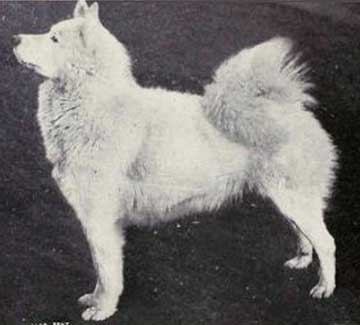 Left, a Samoyed dog from 1915. (Photo from Wikipedia, in the public domain.)
Left, a Samoyed dog from 1915. (Photo from Wikipedia, in the public domain.)
The Samoyed dog is also a northern or spitz-type breed, originating as a reindeer herder among the nomadic Samoyedic peoples of Western Siberia. It is, in fact, likely to be the same dog as the Nenets herding dog, as many of them were all-white. The herding laika was described in 1903 by Mrs Kilburn Scott, writing about Samoyed dogs in Britain:
"He is not, as anybody might think, from his sturdy frame, at first sight, an essentially sleigh-drawing dog, although he may be used as a beast of burden on occasion, but he is to the Samoyed as the collie is to the shepherd on the hills...[and] the Samoyed, who does not care two straws about looks or pedigree, will not part from a tyke that knows his business. Moreover, that business is a fairly tough one. The Samoyed is an Arctic nomad, wandering...with his herds of reindeer, which he leaves perforce to forage for themselves. It is when he wants to move on, that the pack of dogs goes circling round the herd of reindeer, numbering perhaps seven or eight hundred, while their master...lassoes away until he has secured a team. That is the main value of the Samoyed dogs..."
The first all-white Samoyed dogs came to Europe through the auspices of the English captain Joseph Wiggins (1832-1905), a pioneer of the northern sea route to Siberia and the man that made the Trans-Siberian railway possible by transporting rails by ship. Twice he reached the Ob River, and five times carried cargo to the Yenisei and travelled up that river for over 3000 kilometers (almost 2000 miles--this fact alone is indicative of the breathtaking size of Siberia). It is thought that he brought dogs back to England. He also facilitated the acquisition of dogs for the Nansen expedition to the North Pole due to the friends he made in Siberia.
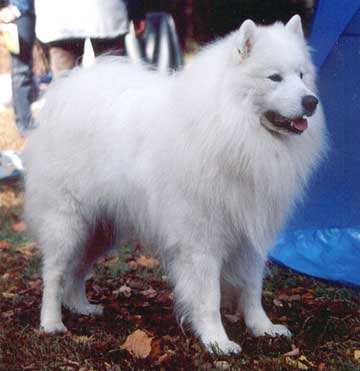 Right, a modern show variety of Samoyed dog. (Photo by "Pleple" from Wikipedia and reprinted with permission under the GNU Free Documentation License 1.2.)
Right, a modern show variety of Samoyed dog. (Photo by "Pleple" from Wikipedia and reprinted with permission under the GNU Free Documentation License 1.2.)
Dogs that accompanied Fridtjof Nansen and Hjalmar Johansen on their journey to the North Pole in 1893-1896 are considered the progenitors of the modern Samoyed dog. Marina Kuzina of the Primitive Aboriginal Dogs Society described the acquisition of the dogs and their voyage. In 1892, Nansen sent a Mr. Trontheim, "a man with experience and knowledge of the north," to the region of the Sosva River, a tributary of the Ob, to purchase thirty...:
"...dogs suitable for work in harness. At this time there [was a] great gathering of the Ostyaks [Ostyaks is an old Russian name for the Ket] and Samoyedes [Nenets, Enets, and Nganasan]...Trontheim bought 33...dogs.... He also hired a Zyryan [Zyryan is an old name for the Komi] with a herd of 450 head of reindeer to deliver [him] with his dogs...to Yugor Shar...The Zyryan reindeer breeders were on their route in seasonal travel with their families, including wives and children. Therefore, in the evening they set up their chums, started bonfires and cooked food for [the] people and dogs. Then, the entire camp fell asleep, leaving the guarding duty to [the] small reindeer herding dogs. In the early morning... with the help of the same dogs, the Zyryan gathered their reindeer, packed their chums and took off again."
At Khabarova they met Nansen and his ship. Nansen took 28 dogs to the North Pole, but none of them survived. The rest, including a bitch with pups, were left aboard the ship. In April of 1893 the bitch had another litter, most of them white. Later, two other bitches had litters and Kuzina says, "According to fragmentary data from the notes left by Nansen...all the dogs were strong, tough and excellent at pulling sleds; they worked very well in hunting Polar bears [as well]." Keep in mind that the Polar bear is the worlds largest predatory land animal with males weighing up to 1500 pounds. It is likely the dogs harried the bears until the men could kill them with guns.
The Samoyed is a medium-sized dog, slightly larger than the Border Collie, and comes in solid white, biscuit (light tan), or a combination of both. Like all Northern breeds, the Samoyed has a heavy, dense, double coat. As you can see from the 1915 photo of a Samoyed with a moderate coat, recognition by kennel clubs has produced a longer, heavier coat yet, which may interfere with the breed's herding and pulling ability. In fact, according to Sarah de Mouchy and Pieter Keijzer, writing for the Newsletter of the Primitive Aboriginal Dogs Society in 2005, "the aboriginal Samoyed dogs, the dogs living with the Samoyed peoples, differ considerably [from] that of the Samoyed dogs now living in the Western...world. The modern Samoyed dogs, thanks to the ever increasing demand to score [at] dog shows, have even undergone a considerable change in exterior compared to the aboriginal Samoyed dogs." As we have seen before, the Sámí Reindeer herders of Finland prefer the moderately smooth-coated Lapponian Herder to the long-coated Finnish Lapphund, as they believe that snow sticks to the longer coat making it difficult for the dog to move comfortably. The same is likely to be true of the herding dogs of Siberia. Furthermore, close breeding of the Samoyed has produced a modern dog with numerous inherited health concerns. The Samoyed fortunately has a gentle disposition, probably due to the fact that the Samoyed people brought their dogs into their tents at night. Whether the Samoyed dog developed from sled dogs or herding dogs, there are people today who sled race with them and others that herd with them, but generally only as hobbies.
Other Uralic-Speaking People
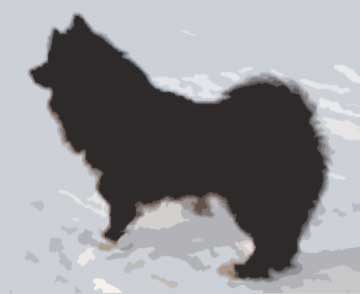 Right, a silouette of a Komi herding dog. (From an original photo by Brian and Cherry Alexander.)
Right, a silouette of a Komi herding dog. (From an original photo by Brian and Cherry Alexander.)
Other Uralic-speaking people within our area of discussion are the Komi, who speak a Permian-Uralic language (a different branch of Uralic family from Samoyedic). They occupy the Komi Republic which lies west of the Ural Mountains (thus, in Europe) but there are Komi living in the Nenets Autonomous Region and some of the Komi reindeer migration routes go deep into Nenets territory. They have been herding reindeer for about three hundred years. It is said that they learned to use reindeer for transport from the Nenets, but developed their own reindeer herding system. Only part of the extended family migrates with the reindeer. The other part is settled in towns. For the Komi, reindeer herding has always been a commercial venture. They use herding dogs, similar if not the same as the Nenets' herding laikas and it is said that they got them from the Nenets.
A third group of Uralic-speaking people are those whose languages fall into the category of the Ob-Ugric group. The Ob-Ugric people arose from a group of proto-Ugrian nomadic horse breeders that inhabited the forest-steppes of Western Siberia south of the Ural Mountains during the Bronze and Early Iron Ages. Ob refers to the major river of the area. During the 9th century AD, the Magyars broke away from this group and migrated to Central Europe, forming the nation of Hungary. Other Ugric groups moved north adopting a hunting, fishing, and reindeer breeding lifestyle. Remnants of these people live on in two minority ethnic tribes, the Khanty and the Mansi, living in the Khanty-Mansi National District of Siberia just east of the Urals. Genetic testing on Mansi indicated that human expansion during the Paleolithic may have reached this part of Siberia before splitting into western and eastern populations. The Khanty are fishermen, hunters, and reindeer herders. The Mansi are hunters and fishermen but they were at one time beekeepers and cattle breeders as well, and the northern Mansi bred reindeer. "Mansi" means "forest dweller". There is no indication that either the Mansi or the Khanti used dogs for herding.
Turkic Peoples
Siberia, China, and Central Asia are home to a large group of people that speak languages in the Turkic family. Those that live in Siberia include a great many in the south, west of Lake Baikal and north of the Mongolian border, and the people of the Altai Mountains region who are descendants of horse nomads of the Russian Steppe. They are pastoralists, mostly of horses and sheep. It is unclear if any of these people use dogs for herding. They may have dogs, but mostly for flock guarding and alerting the people to predators and thieves.
Yakut
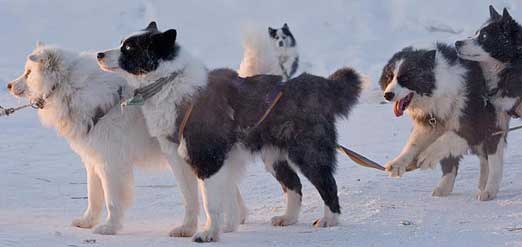 Left, a sled team of Yakut laikas. (Photo by Ajar Varlamov and reprinted with kind permission from the photographer. )
Left, a sled team of Yakut laikas. (Photo by Ajar Varlamov and reprinted with kind permission from the photographer. )
The northern branch of the Turkic language family in Siberia is represented by a people called the Yakut. The southern Yakuts breed horses and cattle, while the northern Yakuts are hunters and breeders of reindeer. These people originated around Lake Baikal but by the 13th century they began migrating north to the Lena River basin. Today they are the majority population of the very large Sakha Republic or Yakutia, the largest sub-national autonomous region in the world. The Yakut did not use dogs for herding until 1940-1953, when herding laikas were provided to them by the Russian government (see above). However, new blood was never subsequently imported and their breeding lines degenerated. They use laika sled dogs, however, of which Ajar Varlamov, a photographer and musher from Yakutia, says, the "Yakut laika [or] Yakutian Laika is one of [the] Siberian (husky-type) dog breeds originat[ing] in the Kolyma region of the Republic of Sakha (Yakutia), East Siberia". Dogs of this type were likely among the progenitors of the Siberian Husky (see photo that accompanies the Chukchi, above).
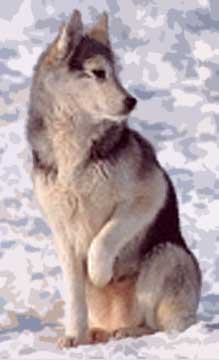
Dolgans
Right, a Dolgan laika. (From an original photo by Brian and Cherry Alexander.)
The Dolgans are another northern Turkic people. They are nomadic reindeer herders that live on the south end of the Taymyr Peninsula. They may also be related to Tungusic people such as the Evenks, below. This is an example of how complicated it is to try to characterize ethnicity in Siberia, or for that matter anywhere in the world. People move about, particularly nomadic people. While other nomadic people of Siberia live in chums (tents) that they take down and transport as they follow the herds, the Dolgans use a balok, a square-shaped wooden hut build on sled runners that the reindeer pull when they travel. These are reminiscent of the "homes on wheels" with which the Huns were supposed to have travelled. The Dolgans use a long pole to prod the reindeer and their dogs run alongside the sleds. The Dolgans' dogs appear to be the smaller reindeer herding laikas, and they are not used as sled dogs, but I found no evidence to prove they use them for herding, so I can only conclude that they are used for hunting and guarding.
Other Turkic-Speaking People
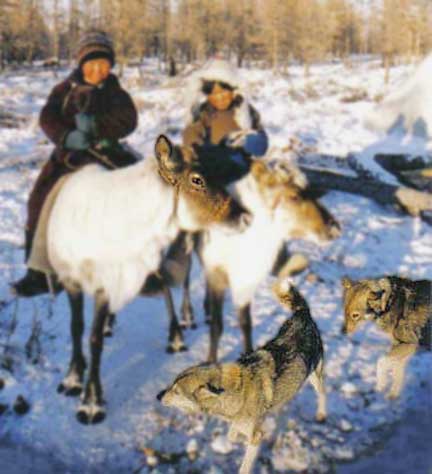 The southern branch of the Turkic language family in Siberia is represented by a large number of groups in the area of the Altai Mountains, and also includes people in northern China, the "Stans" (Central Asia), and the Caucasus. Also Turks are thought to have made up some of the nomadic empires of the Eurasian Steppe, including the Huns and the Xiognu. One large group of Turkic-speaking people are the Tuvans, cattle-herding nomads on both sides of the Mongolian border. They have raised herds of goats, sheep, camels, reindeer, cattle, and yaks for at least a thousand years. In Mongolia they are known as Dukha or Tsaatan.
The southern branch of the Turkic language family in Siberia is represented by a large number of groups in the area of the Altai Mountains, and also includes people in northern China, the "Stans" (Central Asia), and the Caucasus. Also Turks are thought to have made up some of the nomadic empires of the Eurasian Steppe, including the Huns and the Xiognu. One large group of Turkic-speaking people are the Tuvans, cattle-herding nomads on both sides of the Mongolian border. They have raised herds of goats, sheep, camels, reindeer, cattle, and yaks for at least a thousand years. In Mongolia they are known as Dukha or Tsaatan.
Left, two Tuvan children riding reindeer accompanied by a pair of laika dogs and below right, a group of Tuvan nomads traveling with all their goods on the backs of reindeer. Notice the white dog in the foreground. (Both photos courtesy of Alan Wheeler.)
Tungusic Peoples
In Asia, and particularly in Siberia, ethnicity and language are complicated subjects. The Tungusic language group is classified as part of the hotly debated Altaic language family, along with Turkic and Mongolic languages (and even Japanese and Korean). Tungusic languages are spoken in eastern Siberia, as well as in the Xinjiang province of north-western China, and in Manchuria. In Siberia, the groups that speak these languages are the Evens, the Evenks, and a few other groups. The Evens and the Evenks are closely related, and both groups are nomadic reindeer herders. They ride their reindeer and use them for milk, transport, and draft. Their skill at riding allowed them to colonize large areas of the taiga, from the Ob to the Okhotsk Sea, and from the Arctic Ocean to Manchuria. There is also a very large Evenk population in China. The Evenks have been reindeer herders since 1600. Neither group use dogs for herding, but they do use laikas for hunting.
Mongolic People
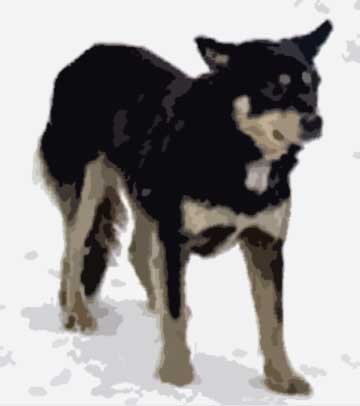 Left, a Buryat dog. (From an original photo by photographer, Susan Gilman.)
Left, a Buryat dog. (From an original photo by photographer, Susan Gilman.)
The Buryats are the largest indigenous group in Siberia and a major northern subgroup in Mongolia. They speak a Mongolic language. Most live around the area of Lake Baikal where they are thought to have originated. Perhaps their language was not always Mongolic, but in the 13th century, Mongolians road north and conquered them. They are horse and sheep pastoralists living on the eastern Russian Steppe. They have dogs of the laika type, though it is not clear that they use them for herding, and they have large guardian dogs The Buryats herd from horseback, using a long pole with a noose on the end that can be pulled taught to prod straying sheep or horses back into the herd or to catch one.
Special thanks go to
Igor Nazarenko, Libby Peachey, Ajar Varlamov, and Alan Wheeler
for their invaluable help.
Copyright © 2014 by Carole L. Presberg
Resources:
Alexander, Brian & Cherry. Arctic Photo, Arctic and Antarctic photographers (www.arcticphoto.co.uk/).
Anthony, David W. The Horse, The Wheel, and Language: How Bronze-Age Riders From the Eurasian Steppes Shaped the Modern World, Princeton University Press, 2007. [Note: linguists can tell from words that are included in the vocabulary of a language, for example, words for fish, words associated with hunting, a word for dog, etc., where people lived and how they lived.]
Author unknown. "Mrs. Kilburn Scott's Samoyeds", Country Life, March 7th, 1903.
Borodovsky, Andrey. Quoted in The Daily Mail online, Mar 31 2013, (www.dailymail.co.uk/news).
Dalzell, Bonnie. "About Spitz Breeds", www.netpets.org/dogs/reference/breedinfo/spitz.html.
de Mouchy, Sarah, and Pieter Keijzer. "On the Preservation of a Cultural Heritage", Newsletter of the Primitive Aboriginal Dogs Society, 2005.
Derbeneva, Olga et al. "Traces of Early Eurasians in the Mansi of Northwest Siberia Revealed by Mitochondrial DNA Analysis", The American Journal of Human Genetics, April 2002.
Kuzina, Marina. "Brief History of the Samoyed", Newsletter of the Primitive Aboriginal Dogs Society, 2004.
Pennisi, Elizabeth. "Ancient DNA: Old Dogs Teach a New Lesson About Canine Origins", Science, 15 November 2013 (www.sciencemag.org/content/342/6160/785.full).
Presberg, Carole. "Collie Types in Northern Europe, International Sheepdog News January/February 2013.
Volkova, Vera Vasilyevena. "Forgotten Expedition", Newsletter of the Primitive Aboringinal Dogs Society, 2006.
Vahtre, Lauri, and Jüri Viikberg. The Red Book of the Peoples of the Russian Empire, Estonia, 1991 (www.eki.ee/books/redbook/foreword.shtml).
Varlamov, Ajar. "SiberianHuskie.co - Yakut Laika" (www.facebook.com/YakutLaika).
Return to
![]()
BORDER COLLIE COUSINS
THE OTHER WEB PAGES WE MAINTAIN
These web pages are copyright ©2014
and maintained by webmeistress Carole Presberg
with technical help from webwizard David Presberg
ALL RIGHTS RESERVED
If you are interested in using ANY material on this website, you MUST first ask for permission.